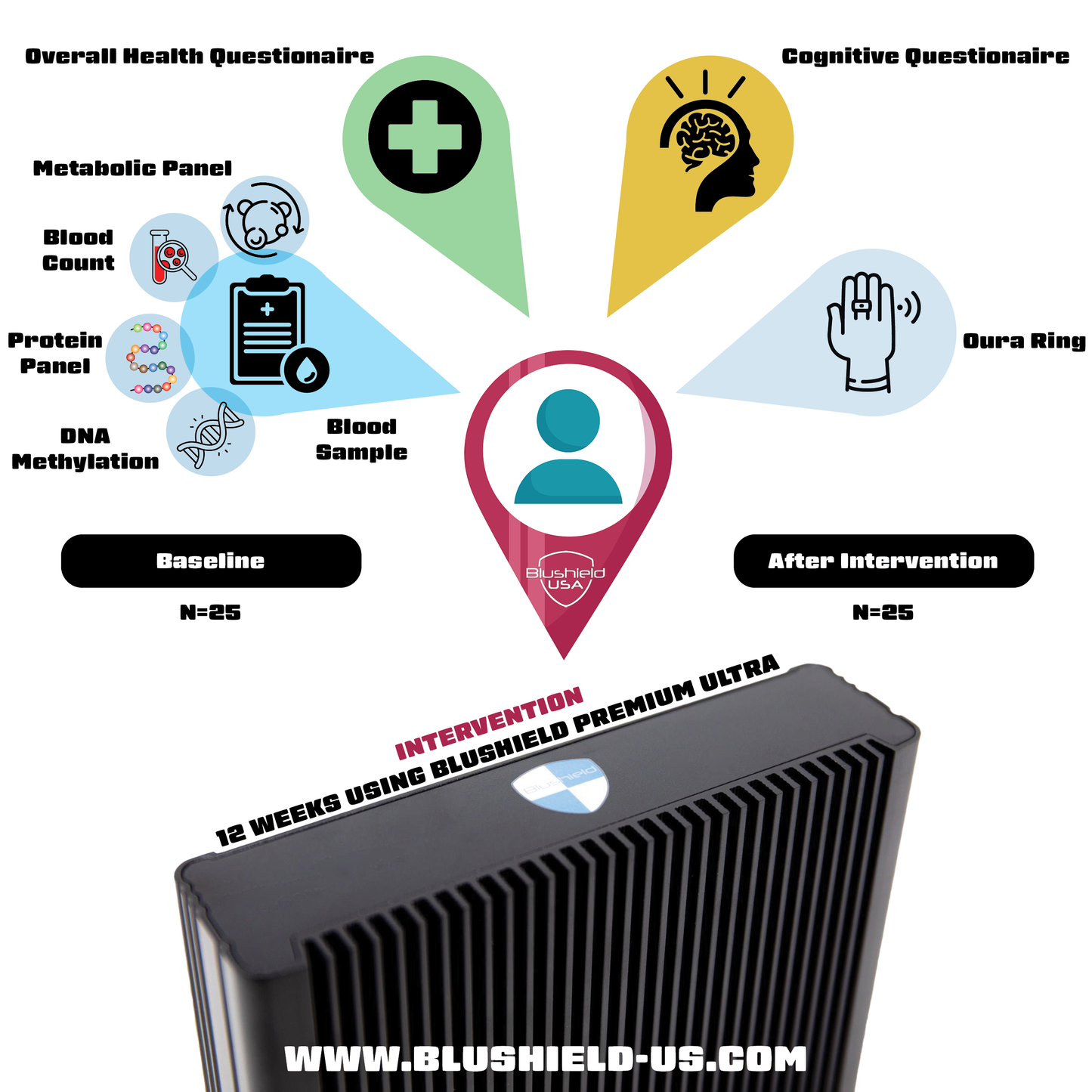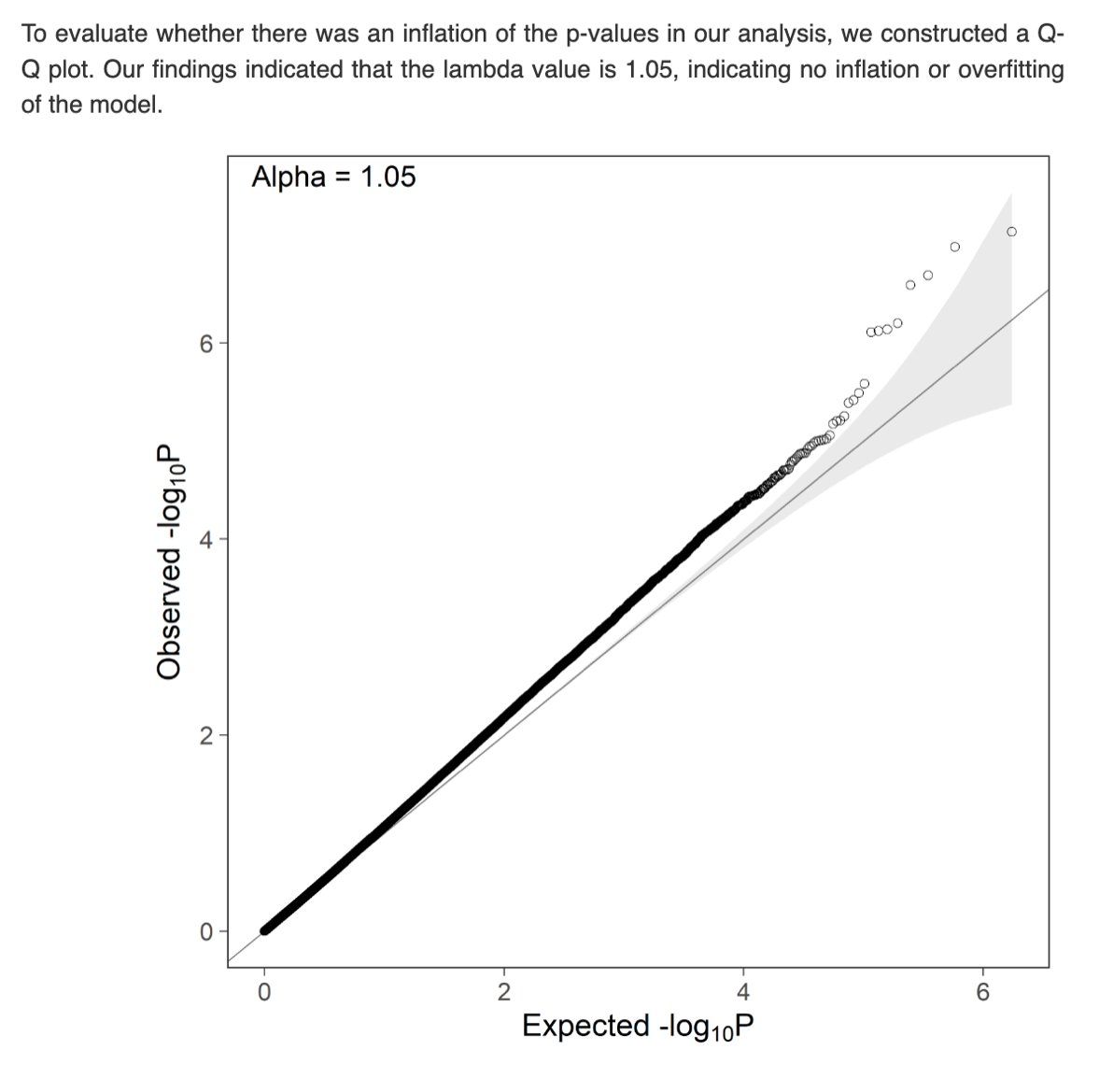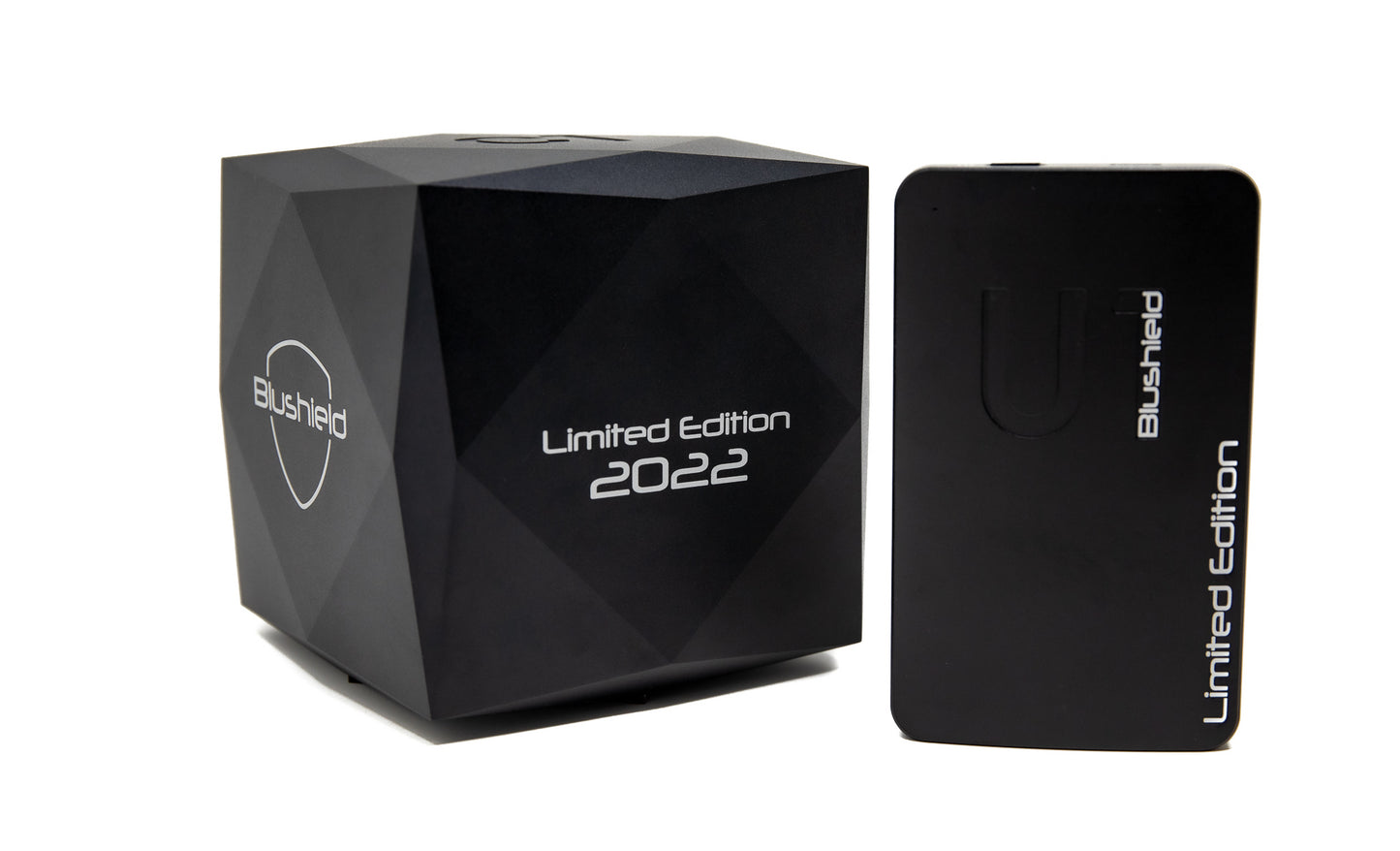
Almost three years ago (back in September of 2020), we were contacted by Tom Blue, the owner of a research company and Executive Director of the American Academy of Private Physicians. Tom is connected with a large network of doctors. He had recently discovered Blushield EMF protection devices, and noticed significant positive results from using the devices on himself, his wife and their son. All three regularly track various health markers using the Oura Ring device, and the results they found in their sleep quality and heart rate variability were impressive enough to inspire Tom to reach out to us.
Tom proposed studying the health effects of our devices on humans, on a larger scale than we have done previously. Tom and his partners, Helen Messier, MD, PhD and DeAunne Denmark, MD, PhD, had great ideas about the structure and focus of the study, a variety of health markers to track, and how to recruit participants within their network of doctors. They had connections with independent labs that could perform the study for us.
Many months were spent ironing out seemingly infinite details, signing contracts, recruiting all our participants, and navigating the biggest worldwide slowdown of many of our lifetimes in the form of the Covid lockdowns, which kept pushing off our ideal timeline. Finally, in March of 2022, test kits were made and sent to all the participants, as well as a Premium Ultra home device for each participant, and a Plugin and/or Premium Portable for the participants who worked away from home or traveled often, to make sure they were within the Blushield field as often as possible during the 12-week study duration.
The focus of this pilot study was to assess the feasibility and preliminary signs of efficacy of our devices on a small sample group within a fairly short time frame, to determine if a full-scale research project would be worth planning in the future.
All 25 participants worked in the health and wellness industry, including general practitioners and physical therapists, and all were self-reported to be in relatively good health at the beginning of the study. This was a single-arm study, in this case referring to a “before and after” type study, where all participants were tested before using Blushield, then again during and after 12 weeks in the influence of the Blushield device.
100% of participants reported compliance with device usage for the study duration, meaning they remained within the Blushield field, which increases the validity of the results and the feasibility (ease and practicality) of using the devices, even for the busy professionals in our study sample. No adverse events were reported during the 12-week study.
A variety of health markers were tested, using several methods. These included laboratory panels assessing overall physiological health; a panel of blood markers related to inflammation, oxidative stress, DNA damage and cellular senescence; a genome-wide assessment of DNA methylation (including the voltage-gated calcium channel sites); a full neurocognitive assessment every 4 weeks of the study; the use of a wearable health tracker (the Oura Ring) to analyze changes in sleep quality, heart rate variability, and related health markers; and self-reported health questionnaires.
Currently we cannot publish the actual manuscript of the study because it is under review by a prominent medical journal. We will post a link to the full study manuscript right here once the journal has reviewed it.
Analyzing and interpreting the results
Although we aren't able to share the actual manuscript yet, it is complete, and we are allowed to share our interpretation of the results. Once you are able to read through the paper yourself, you may be wondering what some of the terms mean, and want more explanation of the significance of each finding.
Our study paper was written by Christopher D’Adamo, PhD, an epidemiologist who has served as Principal Investigator on a wide variety of observational and interventional studies of nutrition and other healthy lifestyle modalities, and his findings have been published in several well-known peer-reviewed scientific and medical journals, and publicized through several popular media outlets.
The study co-authors include the researchers involved in compiling and interpreting the data: researchers from TruDiagnostic (the epigenetic data analysis company that provided the genome-wide DNA methylation assessment), doctors Helen Messier and DeAunne Denmark, who organized the study, and Tom Blue, who got the ball rolling initially.
In the study paper, it is stated: “Preliminary data from in vitro and agricultural animal studies suggest changes in biomarkers of health and functional status may be detectable after a period of continuous BluShield device usage.”
This refers to our prior Blushield studies from several years ago, the grassroots-style testing where we initially found impressive positive results on animals and humans, including live blood cell analysis, human urine analysis, as well as health improvements in chickens and cows.
We knew it was time for a more thorough study on a greater number of human health markers, using a newer, more powerful Blushield device, and we are so excited that our study has been completed.
So, what improvements were found in this independent review board certified pilot study?
Cognitive function improvements
The CNS Vital Signs test is a full neurocognitive assessment that each participant did once before introducing the Blushield device, then again every 4 weeks of the 12-week study, for a total of 4 times. The test records performance in areas of cognitive function, including memory, executive function and processing speed. Statistically significant positive results were found in the areas of composite memory, cognitive flexibility, executive function, and processing speed. There were several areas where no changes were noted (visual memory and simple and complex attention), but the areas of positive change are quite notable.
Electromagnetic field exposure has been definitively linked to impairments in cognitive function, and the mechanism of harm theorized as overactivation of the voltage-gated calcium channels, as described in our previous article on the subject:
Memory, Learning & Attention Impairment From EMF Exposure
Voltage-gated calcium channel improvements
Could our positive results on cognitive function be linked to the voltage-gated calcium channels (VGCCs)? The study paper states this is a valid hypothesis that warrants further exploration. The reason it is believed there may be a link is because in the genome-wide DNA methylation assessment, they were able to identify a key VGCC gene (CACNA1G) that was hypermethylated, indicating a likely under-expression of that gene – basically, a quieting of the voltage-gated calcium channels that are chronically overactive and overstimulated in the constant presence of modern levels of EMFs. Hypermethylation is most often associated with a downregulation of the expression of a gene, placing it into a “locked” state, whereas hypomethylation usually refers to active expression and transcription of a gene.
204 total CpG sites were found to be differentially methylated between the before and after measurements, and 94% of those genes were hypermethylated. A considerable number of these sites were connected with the ATP-sensitive potassium channels, which are known to be influenced by EMFs. Besides the one key VGCC gene that was hypermethylated at a level of statistical significance, 4 other VGCC-related genes were very near the threshold of significance.
 |
 |
CpG is short for Cytosine-phosphate-Guanine, which is the most common methylation pathway in the DNA. DNA methylation is an incredibly important epigenetic health marker. Epigenetics refer to the study of genes activating or silencing (commonly through methylation) in response to changing environmental factors, and can explain why family members (even identical twins) with close to or exactly the same genome can experience widely different health outcomes. It calls upon the “nature versus nurture” question, where “nature” is the static state of the genome or genetics you were born with, and “nurture” refers to the various outside influences you have encountered throughout your life that actually switch various genes on and off, dynamically altering the trajectory of your health.
Another fascinating purpose of DNA methylation is to silence intragenomic parasites. It’s hard to believe, but at least 35% of our genome is made up of parasite DNA. These parasites are called transposons, and include endogenous retroviruses that have inserted themselves into human DNA over a very long period of time, long before each of our lifetimes. DNA methylation, when it functions optimally, should keep this parasitic DNA in a quiet, dormant state for our entire lives. When environmental influences, like toxic heavy metals and electromagnetic fields, disrupt our bodies’ ability to methylate properly, dormant retroviruses can become active, often wreaking havoc throughout our entire bodies.
Meaningful improvements in sleep quality and heart rate variability
All study participants wore an Oura Ring device throughout the entire study duration, from the pre-Blushield “before” period, and during the 12 weeks of Blushield use. This wearable health tracking device continuously records a variety of relevant and important health markers, making it easy to track the effects of lifestyle changes in real time.
The device tracks the full sleep cycle of its wearer, and provides detailed data on the number of minutes of deep sleep, REM sleep, light sleep and awake time. It also records heart rate variability (HRV) on an ongoing basis, which is a key marker of vitality, resilience and adaptability. “Variability” refers to our heart’s ability to respond immediately to the demands of our environment, by speeding up or slowing down the heart rate as needed. The body’s ease in changing the speed of the heart instantaneously is strongly linked to our overall health and vitality.
You can learn more about the complex nuances of heart rate variability in this article we wrote:
Heart Rate Variability (HRV) as an Advanced Biomarker is Affected by EMFs
Our study participants saw impressive improvements in their heart rate variability, average and lowest resting heart rate, body temperature, and deep sleep, all reaching statistical significance. Average deep sleep time increased by 9 minutes, from 90 minutes before to 99 minutes after. There was also an increased average awake time (by 5 minutes), which in some instances wouldn’t be desirable, but it’s a logical assumption that if you’re getting 9 extra minutes of deep sleep (the most restorative type of sleep) per night, then you may not need quite as much sleep overall.
Reduction in blood glucose
EMF exposure has been shown to be linked to elevated blood glucose, and in some cases, even prediabetes and diabetes. This is thought to be related to the voltage-gated calcium channels, which our previous article on blood glucose and insulin elaborates on:
Blood Glucose & Insulin Negatively Affected By EMFs
All of the participants had glucose levels within a healthy range at the beginning of the study, and we still found a statistically significant reduction in blood glucose during the study. The results may have been even more dramatic if diabetics and prediabetics had been included in the study, and is a topic of particular interest for a potential future study.
Glucose and insulin are also strongly affected by the ATP-sensitive potassium channels, so it’s possible that the positive effects on blood glucose may be linked to the hypermethylated ATP-sensitive potassium channel complex that our study recorded, as well as the VGCCs.
Changes in immune markers & self-reported health improvements
The study also found an increase in monocytes and a decrease in natural killer cells (NK cells), both within a healthy range. Monocytes remain in their basic form in the bloodstream and organs when there are no active threats, but as soon as a threat is perceived, they differentiate into either macrophages or dendritic cells. However, NK cells remain in their original form while fighting infection. When monocytes differentiate into dendritic cells, this then alerts other cells (including NK cells) of the presence of an imminent threat.
There is a hypothesis that electromagnetic field exposure triggers the immune system, as our bodies perceive the foreign frequency patterns as invaders it needs to attack and defeat. Since there is nothing physically present to attack and destroy, this can result in a chronically elevated immune response, which will eventually deplete the immune system of its power and steal vital resources from other essential processes in the body. Our long-held theory, based on the results of our previous studies, is that being in the influence of a Blushield gives the body a healthy field to preferentially resonate with, calming and subduing the futile immune response against the perceived invasion of the harmful fields.
An increase in circulating monocytes could indicate that they are now “ready and waiting” in their natural form, and not currently in the process of fighting infection by differentiating into other forms. A decrease in natural killer cells could signify the immune system calming down from a previously chronically overactive state, as the monocytes are not actively signaling a threat that would tell the NK cells to get to work. More targeted and larger scale studies will be needed to confirm this hypothesis.
Also, each participant was given a self-reported health questionnaire at various times throughout the study period, and there was a statistically significant improvement in the participants’ subjective experience of overall health and well-being.
Understanding P-values and confounding factors
To fully understand the study paper (once it's available publicly), it is helpful to understand P-values, as they are the calculations used in clinical studies that determine whether a result is statistically significant, or more likely to be random and insignificant.
P-value stands for probability value, and is directly connected to a concept called the “null hypothesis”. This refers to the potential that exists in every scientific study that the intervention (the device, drug, or other influence) being studied is not having any positive or negative effect on the participants, and therefore the results found are due to random chance. To achieve statistically significant positive results, you want the p-value to be as low as possible. The lower the value, the less likely the results are due to random chance, and if it’s low enough, that means it’s almost certain that the study intervention is truly affecting the study subject. Even when the value is extremely low, there’s always still a tiny possibility that it’s due to chance, which is why the number can never reach zero.
Depending on the parameter being studied, the significance threshold of the p-value is set at a certain number. P<0.05 is a common one, which most of our study parameters used. 0.05 means 5%, so P<0.05 means “the probability that this result is due to random chance is less than 5%”. Any results with a lower number than that threshold will be considered statistically significant.
So if you see a study result with a p-value of p=0.01, that means there is only a 1% chance that the result was achieved randomly, and a 99% chance that the intervention (in our case, the Blushield device) directly affected the results, as we saw in our study in the area of resting heart rate. Some of our other results got even lower p-values like p=0.0007 (our cognitive flexibility result), which means there was only a tiny fraction of a percent chance of the result being random.
Later in the study paper, there is a discussion of confounding factors. This refers to uncontrollable factors in the study design that may have influenced the results, which are essential to consider in any study that lacks a control group. Some confounding factors are external influences that occur during daily life, and in this case, confounding factors may include changes in physical activity or diet due to changes in the season. Another factor to consider is a lack of diversity in the health status, education level and race of the test subjects. All study subjects self-reported as relatively healthy, whereas if more chronic illness sufferers had been studied, there may have been even more room for improvement from baseline.
Accuracy score of our methylation results was very close to perfect
Observing changes at the DNA level is a very complex process, as I’m sure you can imagine. Those performing the measurements must have specific and extensive training, and they have to create a model to factor in all the variables (age, sex, immune markers, and an infinite number of other potential variables), so that the result achieved is as accurate as possible. The theoretical goal is to set up a model that shows pure cause and effect, where variables applicable to this particular study group (called covariates) are factored into the model in a “perfect fit”. Pure cause and effect, in our case, would be results that measure exactly how Blushield use affected methylation of the CpG sites, with the model already having been adjusted to erase the impact of the covariates on the results.
There are ways for them to assess the accuracy of the model used in finding the most pure results, although it’s impossible to make a perfect fit. The perfect score is a “1” – anything less than 1 means there are too many covariates and the results aren’t as significant as they would be in a pure model. A number higher than 1 means there are not enough covariates, and the results are more significant than they should be. Our study’s model was mapped on something called a Q-Q plot, which gave us a score of 1.05. This score is almost perfect, and we were told that this is not easy to get.
This means that the methylation results we saw on the CpG sites, including the voltage-gated calcium channel genes, were almost as pure and accurate as they possibly could have been.

|
 |
Final thoughts
This study was a long time in the making, involving extraordinary levels of hard work and patience. Almost daily here at Blushield, we hear reports directly from customers (and the reviews they post voluntarily on our website) that these devices have affected their lives in positive ways, and some even call them life-changing. Honest reports from customers are helpful for informing new potential customers of what others have experienced, to clarify their decision to invest in our EMF protection devices.
Now, with our first independent review board certified clinical study results under our belt, customers can be even more fully informed of the potential benefits this technology may have on their lives. Although it was a fairly small-scale pilot study, in some ways this study is actually groundbreaking, as we are the first EMF protection company that we’re aware of to test the effects of our devices on the voltage-gated calcium channel genes, and find notable improvements. This is something we will certainly be testing more extensively in future, larger scale studies.
The study paper concludes that Blushield devices appear to be feasible, safe, and associated with improvements in cognitive function, sleep, heart rate variability, voltage-gated ion channel gene normalization, blood glucose, immune response, and overall self-reported health among relatively healthy adults. It also emphasizes that the devices “appear to be a reasonable component of a comprehensive EMF mitigation strategy to minimize RF exposure”, which is always how we encourage people to use our devices.
You are welcome to share this with anyone in your life who is concerned about the harmful effects of EMFs, and is looking for sound and researched-backed solutions.
References:
- “Cytosine methylation and the ecology of intragenomic parasites” – https://www.cell.com/trends/genetics/pdf/S0168-9525(97)01181-5.pdf
- “P-Value And Statistical Significance: What It Is & Why It Matters” – https://www.simplypsychology.org/p-value.html
- “Epigenetics: The Science of Change” – https://www.ncbi.nlm.nih.gov/pmc/articles/PMC1392256/
- “ATP-sensitive potassium channelopathies: focus on insulin secretion” – https://www.ncbi.nlm.nih.gov/pmc/articles/PMC1392256/


